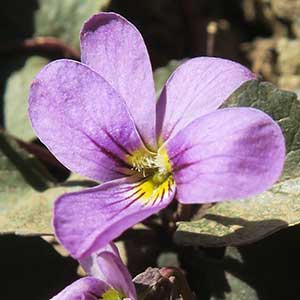Viola flettii
Viola lithion
Flett's violet, Olympic violet, rock violet
rock violet
1–3, ascending to erect, mostly glabrous, on caudex from fleshy rhizome.
1–3, ascending to erect, glabrous, on caudex from fleshy rhizome.
basal and cauline;
basal: 1–3;
stipules linear-lanceolate, margins entire or with glandular processes, apex acuminate;
petiole 1.5–9.7 cm, mostly glabrous;
blade purple-tinted and –veined, broadly reniform to ovate, 0.9–2.4 × 1.2–4 cm, base cordate, margins finely crenate-serrate, eciliate, apex acute to obtuse, surfaces glabrous or sparsely pubescent along veins adaxially;
cauline similar to basal except: stipules ovate to lanceolate, margins entire or shallowly laciniate;
petiole 0.7–5.9 cm, usually glabrous;
blade 0.8–2.1 × 1.2–3.1 cm.
basal and cauline;
basal: 1–4;
stipules unknown;
petiole 1–10 cm, glabrous, sometimes finely puberulent;
blade broadly ovate or deltate to broadly deltate, 1–2.5(–2.9) × 0.6–2.2(–2.6) cm, base usually cordate to truncate, rarely rounded, margins crenate-dentate, eciliate, apex acute, surfaces glabrous;
cauline similar to basal except: stipules lanceolate, margins usually fimbriate-toothed, sometimes entire, apex attenuate or acute;
petiole 1.1–3.7 cm, sometimes finely puberulent;
blade ovate to deltate, 0.7–2.2 × 0.4–1.2 cm, base sometimes rounded on distal blades.
1.8–7.1 cm, usually glabrous.
3–6(–10) cm, glabrous.
sepals lanceolate, margins eciliate, auricles 0.5–1.5 mm;
petals soft reddish violet on both surfaces, all with yellow area basally, lower 3 dark violet-veined, lateral 2 bearded, lowest with white around yellow area, 10–15 mm, spur yellow, gibbous, 0.5–2 mm;
style head bearded; cleistogamous flowers axillary.
sepals lanceolate, margins eciliate, auricles 0.5–1 mm;
petals blue to pale violet on both surfaces with yellow area basally, lower 3 purple-veined, lowest with yellow area, lateral 2 bearded, lowest 5.5–11 mm, spur white to pale violet, gibbous, 0.5–1.3 mm;
style head bearded; cleistogamous flowers unknown.
± spherical, 5–9 mm, glabrous.
subglobose, ca. 5 mm, glabrous.
dark brown to brownish purple, 2.5–3 mm.
dark brown, ca. 1.8 mm.
Viola flettii
Viola lithion
Viola flettii is endemic to the Olympic Mountains of northwestern Washington. C. S. McCreary (2005) noted that although morphologically and ecologically distinct, V. cuneata, V. flettii, and V. ocellata are closely related.
(Discussion copyrighted by Flora of North America; reprinted with permission.)
Of conservation concern.
Viola lithion is known only from the White Pine Range in Nevada and the Pilot Range straddling the Nevada-Utah border. It is related to V. canadensis and V. flettii.
(Discussion copyrighted by Flora of North America; reprinted with permission.)


